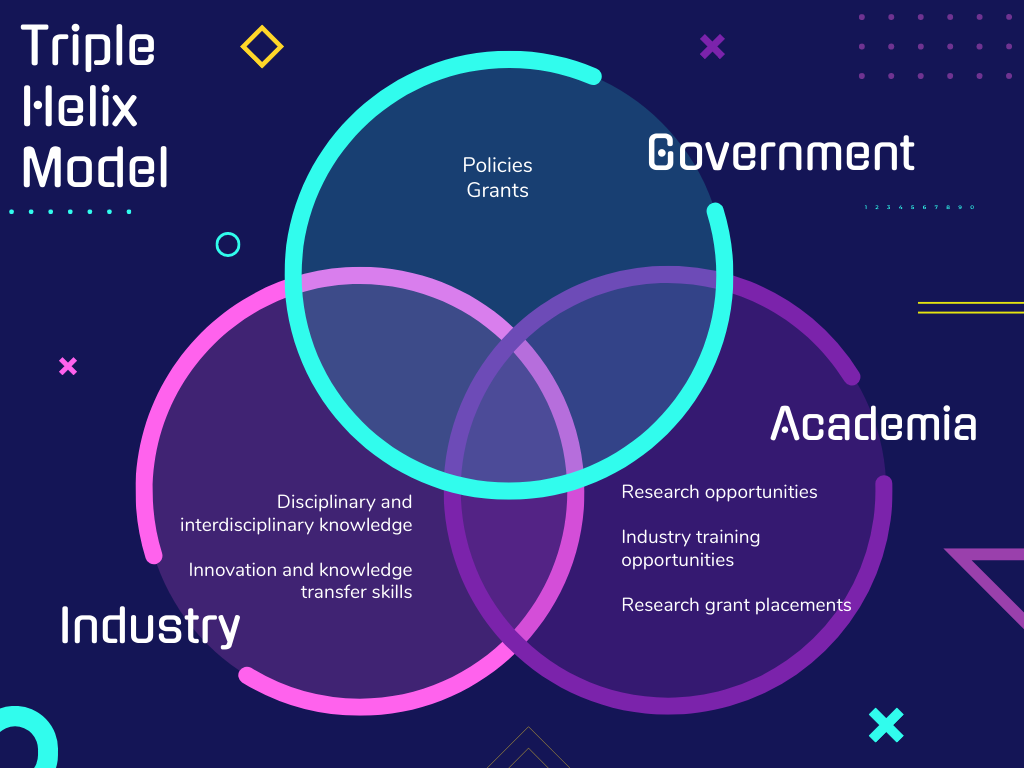
Innovation has become a driving force behind societal progress and economic growth. But how does innovation happen, and what are the key players involved in the process? One conceptual model that sheds light on this complex dynamic is the Triple Helix of Innovation. In this blog post, we will explore the Triple Helix model, its key components, and how it unlocks the collaborative power needed to foster innovation.
The Three Helices: Academia, Industry, and Government
At the core of the Triple Helix model are three distinct institutional spheres, each representing a critical player in the innovation ecosystem:
1. Academic or University Sphere: Universities and research institutions are the engines of knowledge creation and scientific research. The academic sphere generates new ideas, conducts groundbreaking research, and cultivates a pool of talented individuals. Through their educational programs, universities equip students with the skills and knowledge necessary to drive innovation forward. They serve as the foundation for fostering intellectual capital and are crucial in providing a steady stream of new discoveries and insights.
2. Industrial or Business Sphere: The industrial sphere represents businesses, corporations, and industries that translate knowledge into practical applications, products, and services. This helix focuses on the commercialization and application of research outcomes generated by the academic sphere. Industries provide the necessary resources, funding, and expertise to transform ideas into marketable innovations. By collaborating with academia, the industrial sphere can leverage cutting-edge research and tap into the talent pool to drive technological advancements and fuel economic growth.
3. Government or Public Sphere: The government sphere plays a vital role in shaping the innovation ecosystem through policies, funding, and regulatory frameworks. Governments establish supportive policies and initiatives that encourage collaboration between academia and industry. They allocate resources to research and development, facilitate technology transfer, and create an environment conducive to innovation. The government’s involvement ensures a favorable ecosystem for innovation to thrive, addressing societal challenges, and driving economic competitiveness.
Interactions and Collaborations: The Triple Helix in Motion
The Triple Helix model recognizes that innovation emerges from the interactions and collaborations among these three helices. Rather than operating in isolation, the helices intertwine, influencing and shaping each other’s activities. Let’s explore some of the ways these interactions occur:
- Academia-Industry Collaboration: Collaboration between academia and industry is crucial for transforming knowledge into practical applications. Industry provides funding, resources, and real-world expertise, while academia contributes research capabilities, scientific knowledge, and access to talent. This collaboration leads to technology transfer, the development of new products and services, and the establishment of startups and spin-off companies.
- Academia-Government Collaboration: Collaboration between academia and government involves policy-making, research funding, and support for educational programs. Governments often fund research projects conducted by universities and establish research centers to address societal challenges. In turn, academia provides expertise, research findings, and recommendations that inform government policies and initiatives.
- Industry-Government Collaboration: Collaboration between industry and government involves the formulation of policies, regulations, and incentives that stimulate innovation and economic growth. Governments work closely with industries to identify emerging trends, establish industry standards, and create favorable business environments. This collaboration ensures that industry’s needs are addressed and that innovation contributes to the overall socioeconomic development.
The Triple Helix model emphasizes that innovation thrives when these three helices collaborate, exchange knowledge, and leverage each other’s strengths. By breaking down silos and fostering dynamic interactions, the model encourages the flow of ideas, resources, and expertise across academia, industry, and government.
Implications and Real-World Applications
The Triple Helix model has profound implications for innovation policy, research collaboration, and economic development. Governments, industry leaders, and academic institutions can use this framework to inform their strategies and initiatives. By recognizing the interdependencies and collaborations between academia, industry, and government, stakeholders can design policies that create a supportive ecosystem for innovation to flourish.
Several regions and innovation ecosystems around the world have successfully implemented the Triple Helix model. For example, Porto Digital in Brazil and Silicon Valley in the United States embody the principles of the Triple Helix, fostering collaboration and generating remarkable innovation-driven growth.
The Triple Helix of Innovation provides a powerful framework for understanding the complex interactions and collaborations necessary for fostering innovation. By recognizing the unique roles of academia, industry, and government, and fostering a culture of collaboration, we can unlock the transformative power of innovation, driving economic growth, addressing societal challenges, and shaping a better future for all.
